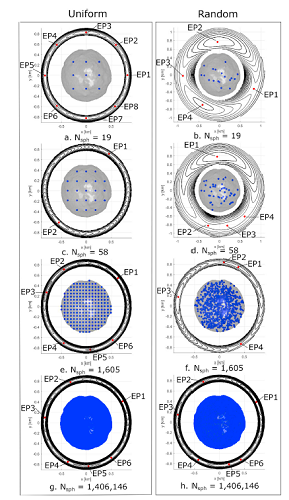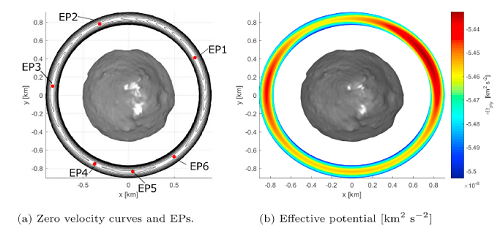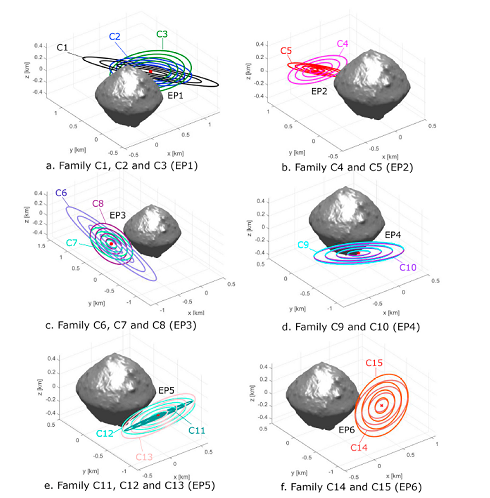The effect of "MASCONS" Sphere Packing onto the Dynamical Environment around Rubble-Pile Asteroids: Application to Ryugu
- University of Liverpool, Mechanical, Materials and Aerospace, United Kingdom of Great Britain and Northern Ireland (stefania.soldini@liverpool.ac.uk)
Abstract: A sphere cluster (SPH-Mas) based gravity model allows a semi-analytic expression of the linearised equations around the equilibrium points. Depending on the sphere packing distribution, the SPH-Mas model can retrieve the same dynamical objects common to others gravity models (i.e. spherical harmonics and polyhedron) or for non-uniform density objects. This model has the advantage to define the same particles mesh distribution for both astrophysical and astrodynamics tools. The Hayabusa2’s Small Carry-on Impactor operation is used as a scenario to study the ejecta particle dynamics around an irregular body. The goNEAR (gravitational orbit Near Earth Asteroid Regions) tool was used to simulate the impact operation in a non-linear sense when the effect of the solar radiation pressure perturbation is taken into account for particles size of 10 cm, 5 cm, 1 cm and 1 mm in diameter.
Introduction: In November 2019, the Japanese Hayabusa2 spacecraft completed an 18 months mission exploration around the asteroid Ryugu [1] and it is expected to return to Earth late this year (2020). JAXA’s Hayabusa2 and NASA’s OSIRIS-Rex missions [2] are contributing to answer fundamental questions related to the formation of our solar system and the origin of Life [3]. After a successful touchdown in March 2019, Japan has set a new first when in April 2019 the Hayabusa2 spacecraft deployed and activated the explosive Small Carry-on Impactor (SCI) to successfully form an artificial crater [4].
We propose a genearlised methodology to study the dynamics around Equilibrium Points (EPs) of irregular bodies with application to the asteroid Ryugu [5]. To the core of our study, we aim to gain a general insight on the dynamics around irregular shape bodies for studying the dynamics of ejecta particles. Moreover, we are looking into a generalised gravity model of celestial bodies that can be easily extended not only to any irregular shape bodies but also to arbitrary density distributions [5]. The selected generalised gravity model provides a mass distribution that can be used for both hydrodynamics impact simulations and orbital dynamics around EPs.
Background: The mascons (“mas”s “con” centrations) has been mainly used for explaining the Lunar gravity anomalies originally detected in 1968 [6]. Conversely, Smooth Particles Hydrodynamics (SPH) codes are often used to simulate asteroid impact events and share the problem to handle the transition between a SPH simulation and N-body simulations [7]. Since the SPH and Mascons make use of the same mass conservation law and we are interested to interface the SPH simulations with the N-Body simulations, we will rename the selected gravity model as the SPH-Mascons (SPH-Mas) model.

Figure 1: Sphere packing and the equilibrium points [5].
SPH-Mas Gravity Model: The gravity of an irregular shape body is modelled with a cluster of spheres, SPH-Mas. Each spherical particle contributes in the overall gravity field of the body. The exterior gravity potential of each sphere behaves as a single point mass. The potential of the irregular body is the result of the summation of each point mass’s potential that contributes to the overall potential field such that:
(1)
where mi (i = 1, ..., Nsph) is the mass of each SPH-Mas for a total of Nsph masses. r is the distance from the field point and the center of the asteroid. ri is the distance of each masses with respect to the center of the asteroid. The total mass of the asteroid is conserved and given by mb = ∑(i = 1,.., Nsph) mi.

Figure 2: Shape model [1] and the equilibrium points.
Sphere Packing: We consider Ryugu’s polyhedron model published in [1] as our “high fidelity” gravity model. We distribute the SPH-Mas within the asteroid shape such that we can approximate Ryugu’s “high fidelity” gravity field. For the scope of testing our semi-analytic formula, we compared a uniform sphere packing approach with a random packing approach for different numbers of SPH-Mas. Fig. 1 shows the comparison between the uniform distribution in the left panel and the random distribution in the right panel for Nsph = 19, 58, 1,605 and 1,406,146. By comparing the location of the EPs between Fig 1 and Fig 2, it is clear that under the assumption of uniform density polyhedron, the uniform sphere packing is preferable to the random sphere packing even for the case of Nsph major to the order of million spheres. Indeed, the random sphere packing does not necessarily preserve the geometry of the EPs that affects the ejecta dynamics.
Effect of SPH-Mas Packing onto Particles Dynamics: The derived semi-analytical formula based on an SPH-Mas gravity model is a direct function of the sphere packing distribution (density), their position (ri) and the asteroid’s spin axis angular velocity (7.6 h for Ryugu) which allows to find families of periodic orbits for ejecta particles around an non-uniform irregular shaped asteroid as shown in Fig 3.
Fate of Ryugu’s Ejecta: We made use of goNEAR tool to simulate the dynamics of 10 cm, 5 cm, 1 cm and 1mm in diameter size particles under the effect of the solar radiation pressure perturbation. In the numerical experiment, few particles seemed to survive in orbit for diameter of 5–10 cm (Fig 4). The search for evidence of particles in Ryugu orbit is still unconfirmed however the stability of EPs can be linked to long survival particles in orbit.

Figure 3: Family of periodic orbits as function of sphere packing [5].
Figure 4: SCI’s ejecta dynamics with the goNEAR tool [5].
References: [1] Watanabe et al. (2019) Science, 364, 268–272. [2] Lauretta et al. (2015) Meteoritics & Planet. Sci., 50, 834–849. [3] Sugita et al. (2019) Science, 364, 6437. [4] Arakawa et al. (2019) Science, under review [5] Soldini et al, (2019) PSS, (2020) 180 [6] Melosh et al., (2013) Science, 340,1552–1555 [7] Ballouz et al., (2018) 49th LPSC.
How to cite: Soldini, S., Saiki, T., Ikeda, H., Wada, K., Arakawa, M., and Tsuda, Y.: The effect of "MASCONS" Sphere Packing onto the Dynamical Environment around Rubble-Pile Asteroids: Application to Ryugu, Europlanet Science Congress 2020, online, 21 September–9 Oct 2020, EPSC2020-808, https://doi.org/10.5194/epsc2020-808, 2020

